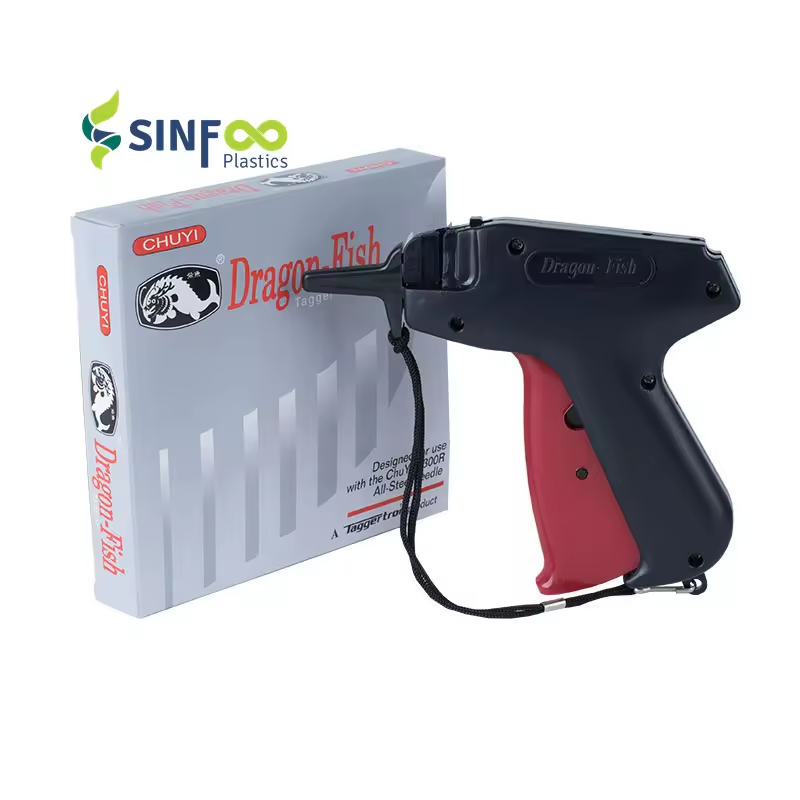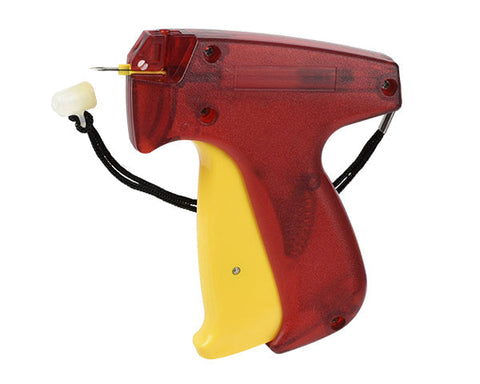The Fashion Retailer's Essential Tool: How to Skillfully Operate a Clothes Tag Gun

What is a Clothes Tag Gun and Its Importance in Fashion Retail
Understanding the Basics of a Clothing Tag Gun
A clothes tag gun is a handheld device used in retail to attach pricing and information tags to garments quickly and easily. By piercing a tiny hole with a needle, a plastic barb is inserted to secure the tag to the item. This tool is essential for retailers to provide necessary product details like price, size, and brand to their customers efficiently. With a tag gun, tagging becomes a fast process, allowing merchandise to be prepared for the shop floor with speed, ensuring a timely and attractive presentation of new stock.
The Crucial Role of Tag Guns in Merchandise Presentation and Inventory Management
Clothing tag guns are vital in fashion retail for two main reasons. First, they help create a neat and enticing product display. By attaching price tags and info labels, they make it easy for customers to find what they need. Second, tag guns are key in inventory management. They make tracking items simple. Each piece of clothing gets a unique tag. This way, store workers can do stock counts fast and spot any missing items. In short, tag guns keep the shop floor organized and the stock list up-to-date.
Step-by-Step Guide to Using a Clothes Tag Gun
Preparing Your Tag Gun: Loading Tags and Needles
Before using your clothes tag gun, it's essential to set it up properly. To begin, select the right type of tags and needles for your clothing material. Here is a simple list to follow:
- Check the Gun Model: Ensure you have the right model compatible with your tags.
- Insert the Needle: Hold the gun securely, push the needle lock forward, and insert the needle.
- Load the Tags: Take a barb strip and insert it into the slot, following the arrow direction.
- Secure the Tags: Gently pull the trigger to check if the tags are properly secured.
- Test the Gun: Tag a piece of scrap fabric to ensure everything is in working order.
Always handle needles with care. If a needle is dull or bent, replace it to avoid damage to the fabric.
The Correct Way to Attach Tags to Different Types of Garments
- Lay the garment flat: Ensure the garment is smooth and flat before tagging to avoid wrinkles.
- Select the tagging location: Common areas include the label, seam, or care tag inside the garment.
- Position the tag gun: Hold the tag gun perpendicular to the garment with the needle pointing down.
- Insert the needle: Push the needle through the selected spot on the garment, making sure it doesn’t catch on multiple layers.
- Attach the tag: Squeeze the trigger to release the tag and fasten it to the garment.
- Remove the gun carefully: Pull the tag gun away gently to avoid tearing the fabric or damaging the garment.
- Check the tag attachment: Ensure the tag is secure and the garment material is not compromised.
By following these simple steps, you can tag different types of garments without causing damage or discomfort when worn.
Safety Measures and Maintenance Tips for Clothing Tag Guns
- Always ensure the tag gun is in good condition before use.
- Keep fingers away from the needle to prevent accidents.
- After each use, clean the needle and mechanism.
- Store the tag gun in a safe, dry place.
- Regularly check for wear and tear on the needle and replace as needed.
- Do not use excessive force when tagging items to avoid damage.
- Read the manufacturer's instructions for specific maintenance tips.
- Use only compatible tags and barbs for your model of tag gun.
- If a jam occurs, gently remove the obstruction, do not force it.
- Consider regular maintenance check-ups if you use the tag gun frequently.
Advanced Techniques and Best Practices for Tag Gun Usage
Mastering Tag Placement for Optimal Shop Display
To make clothes stand out in your store, master tag placement. Here are simple tips:
- Place tags on the left side of garments. Shoppers tend to look there first.
- Align tags at the same height on similar items for a clean look.
- Use clear tags for discreet labeling on premium items.
- Place tags on the manufacturer's label to avoid damaging the fabric.
- Ensure tags are visible but don’t distract from the garment’s design.
- For items on hangers, attach tags where they can be easily flipped to see the price.
Good tag placement can make shopping easier and display clothes better.
Troubleshooting Common Issues with Clothing Tag Guns
Using a clothing tag gun can sometimes lead to issues. It's common and fixable. Here are tips:
- If the gun jams, don't force it. Gently remove the stuck tag.
- Dull needles can tear fabric. Change them regularly.
- Tags not secure? Check if the needle is correctly inserted.
- For misfiring, ensure the mechanism isn't clogged with tags.
- If tags are not feeding, check for a tag jam in the gun.
- Trouble with tag tension? Adjust the gun's pressure setting.
Always check the manual for specific gun troubleshooting.
Enhancing Efficiency with Tagging Strategies for Large Inventories
When handling large inventories, efficiency is key. Here are some tips to speed up the process:
- Organize clothes by type and size before tagging to streamline the workflow.
- Use color-coded tags to quickly identify different categories or price points.
- Set up a dedicated tagging station with all necessary supplies within reach.
- Consider team tagging: one person aligns the garments, the other attaches the tags.
- Implement a quality-check system to avoid re-tagging due to errors.
By adopting these strategies, you can enhance the efficiency of tagging large inventories, saving both time and labor costs.
Related articles:



